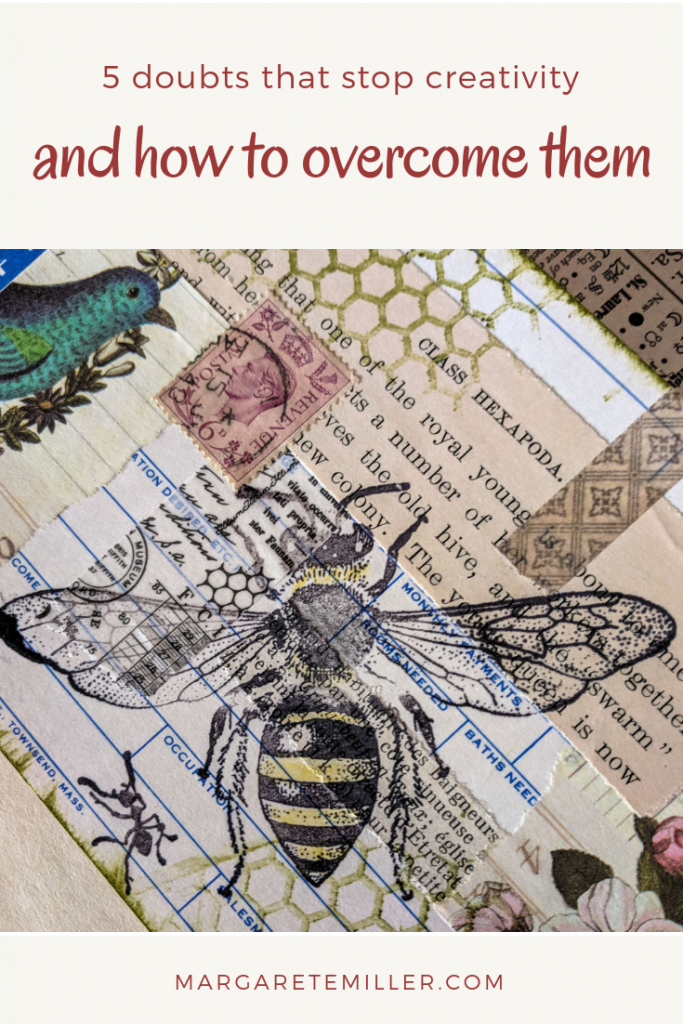5 doubts that stop creativity and how to overcome them
I’m a firm believer that the ability to make good collage art isn’t a matter of talent, it’s a matter of practice; the more you work on collaging, the better you get. Though it may be that some people are naturally born with “the eye”, knowing how to place things in a pleasing manner, this skill is something that can be learned.
Often, the hardest part of doing collage art is starting. Below are five doubts that stop many beginners before they even get started:
- “I don’t know where to begin.”
- “What if I’m doing it wrong?”
- “Aren’t there some rules I should be following?”
- “What if I don’t like what I make?”
- “What if no one likes what I make?”
Let’s go through these one by one.

“I don’t know where to begin.”
To begin a collage you need a minimum of three things:
- a substrate
- paper elements
- glue
a substrate is something you will create the collage on, such as an index card or a notebook page. It can be big or small. It can be new, or a used page in a book that you want to collage over. See my post on What's a gluebook, anyway? for ideas of what kinds of things you can use for a substrate for making collage art.
If you like collage art, it’s likely that you love papers of all kind. Perhaps you’ve been cutting out images but haven’t known what to do with them. Maybe you’ve got a drawer where you stash old ticket stubs, an interesting printed pattern, a used postage stamp, etc. The time to dig them out is when you want to start creating some collages.
Use whichever glue you are most comfortable using. Do you like glue sticks? Go with one of those. A “school glue” might not hold so well over time but you can use anything really, as long as it’s acid free. If you want to use a wet glue, a PVC glue or matte medium are good choices though they’re a bit more fussy, however, and you will need a brush to apply it. Also, be careful not to use too much wet glue or your page will warp. Double-sided tape is another good idea if you are adhering pieces that are made from heavier paper.
“What if I’m doing it wrong?”
The great thing about collage art is that you can gather your elements, and move them around on your page before deciding where you want to glue something down. This little fact is wonderful, particularly if you are short on time and just have a few minutes here or there, throughout your day to make some art. Lay some papers down and come back to it, moving things around, taking away what doesn’t look right and adding something else. Sometimes I have a collage laying out on an out-of-the-way table for several days until I think it looks right.
“Aren’t there some rules I should be following?”
Rules exist, but of course it’s up to the individual to follow them or not. In composing something visual, there is “the rule of thirds”, which is really more of a guideline. Imagine drawing tic-tac-toe lines across your substrate so that you have 9 equal quadrants. The guideline proposes that the more important elements be placed along those lines or where they intersect. In other words, don’t have your most important element in the very center. Following this “rule” is up to you. Experiment and see if it works for you.
One strong recommendation I have, rather than a rule, is to know what you like. It’s helpful knowing what style or type of collage art you like and what you’d like to emulate. Pinterest is a good place to start and worth checking back periodically to get new inspiration.
“What if I don’t like what I make?”
The inner critic is sometimes our worst enemy. If you have doubts about your own abilities and are afraid to try making a collage, ask yourself this: can you dress yourself in the morning with clothes that more or less coordinate? Can you walk into a room in your home and see how the flooring coordinates with the wall paint, with the furniture, and light fixtures (or how it doesn't)? If you said yes to those things, then you can take some random pieces of paper and make them work together using washi tape and maybe some pattern paper. There's logic in collage art. The best thing is that the logic is yours. You get to decide.
“What if no one likes what I make?”
Are you making art for someone or are you making it for yourself? Who is it ultimately intended for? Though we all like the idea of sharing what we make with a receptive audience, it’s important to protect yourself from negativity. Sometimes negativity can come from family, which can make negative feedback very painful. Begin with making art for yourself. After that, look for a supportive environment where you can share your art. I host a community for collage art using a vintage style called the Collage Art Collective. Lots of people post their work and encourage each other. You are invited to create an account and participate if you would like.
For the beginner looking for more information on collage art, see the post I wrote about Getting Started with Collage Art, which also includes a YouTube video with some demonstrations.


